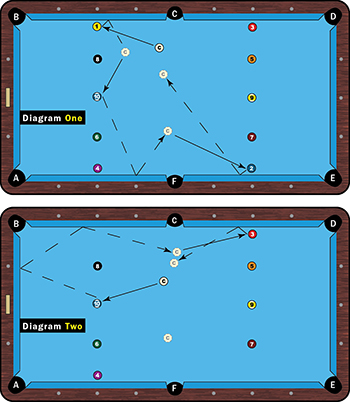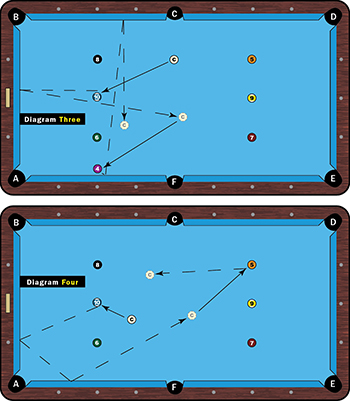Planning three shots ahead and facing last-ball pressure.
One of the biggest mistakes by amateur players is, of course, not thinking far enough ahead and eventually running into trouble or getting the wrong angles for the next shot. If the balls are in the open, most pros will be thinking at least three shots ahead. That will let them visualize the optimal angles for each shot. Rotation is all about angles and whatís next because the next ball is predetermined for you. (Of course, itís equally important to look for problem balls and address them as quickly as possible.)
Hereís a drill that is perfect for thinking three balls ahead and also for playing position on the money ball. Thatís where a lot of amateur players struggle. They get too quick, too excited and nervous. One of the added benefits of this drill is that it will keep you in a good rhythm, which in turn trains your mind to stay calm in key situations. The shots in this drill are shots that come up all the time, so youíll be prepared when it counts.
So, to teach you how to stay three balls ahead and also focus on that money ball (the 10 ball), this drill takes you from the lowest numbered ball on the table to the 10 ball and then from the 10 ball to the next lowest numbered ball. Itís really a great sequence. Just re-spot the 10 after shooting it, whether successful or not. You can never switch off. Focus and concentration are key, which helps create a match environment.
Like most drills, youíre not allowed to bump into other balls.
Starting with cue ball in hand, just use a little draw for shape on the first 10 ball (Diagram One). Leave yourself a nice angle off the 10 ball to come off the long rail for the 2. Draw back across table from the 2 for position on the 10 ball.
You want to play position for the 10 in pocket A because thereís less traffic on the right side of the table with the 1 ball gone (Diagram Two). Thereís less worry about obstructing balls. If you werenít thinking three shots ahead, you may not have noticed that. Play with follow and a little right to bring the cue ball to the bottom rail and around the 8 for position on the 3.

Draw back towards the middle of the table for the 10, again in pocket A so that you have an easy path from the 10 to the 4. If you are on the right side of the 10, you will have lots of options going forward one rail or around 2 rails. I prefer one rail with a touch of left follow for a nice angle on the 4 (Diagram Three).
You can let your stroke out a little on the 4 ball, using follow to go two rails side to side for the 10 ball in pocket B.
Life will continue to get easier because fewer balls on the table allows for more room for the cue ball to travel. Just try to avoid landing along the rail or straight in.
In this sequence, I landed almost straight on the 5 (Diagram Four), but a simple draw will get me back in good position for the next 10. The same shots will get you through the 10 and the following 6 ball.

So, you see how this drill progresses. You need to look three balls ahead so that you know the angles you want to maintain to continue the run.
Itís not an easy drill, but stick with it. Over time you will see real improvement in your position play.





